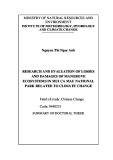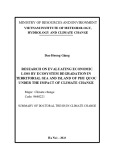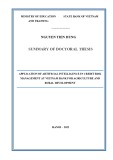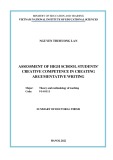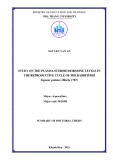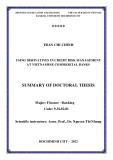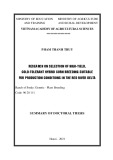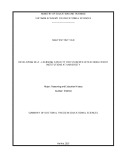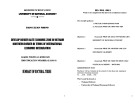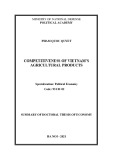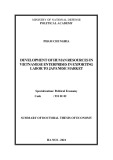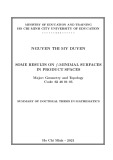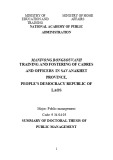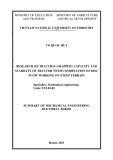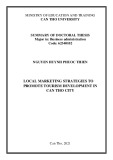2
1
GENERAL INTRODUCTION
1.1. Context of study
example, the economic growth of Vietnam tends to go in a straight line, from the post- crisis low level at 5.25% (2012) to the highest low in the past 10 years at 7.08% (2018). Similarly, many other Asian countries also achieve good growth in 2018 such as China (6.1%), India Degrees (5.1%), Indonesia (5.02%), or the Philippines (6.4%). At the same time, private sector is growing to the point which Nakao (2020) affirmed that the success of the emerging and developing countries in Asia mainly relies on markets and private sectors which play a role as growth engines. The encouraging signs of the emerging and developing economies in Asia result from contributions of a number of macroeconomic policies, of which fiscal policy is among. Hence, the positive effect of public expenditure on private sector is always confirmed.
Public expenditure and private investment have always been highly appreciated by many economists due to their significant roles in economic activities. Moreover, public expenditure not only is one of the basic direct inputs of economic growth but also make indirect influence through the transition effect on private investment. The issue attracts many debations is that the link between public expenditure and domestic private investment is positive or negative. In other words, whether the latter can be multiplied by the positive impact (the the crowding in effect) or be decreased by negative impact (the the crowding out effect).
On the other hand, some economists do not agree with this conclusion because they found the negative impact of public spending on private sector. For example, a prominent matter is that the clear preference of state-owned enterprises over private ones in accessing production resources has contributed to proving the the crowding out effect. Therefore, if public spending continues to be expanded to enhance economic growth and perform other socio-economic tasks, the issue to consider is the direction of the impact of public expenditure on private sector. In the context of the private sector is broadening and private investment is playing an increasingly influential part in many economies, it is essential to have an assessment of this impact to adjust spending policies accordingly.
In view of research, a number of the economists agree with the positive impact of public expenditure on the investment from the private sector (Aschauer, 1989; Blejer and Khan, 1984; Ghura and Goodwin, 2000; Blanchard and Perotti, 2002; Erden and Holcombe, 2005; Gjini and Kukeli, 2012). It is explained that public spending is seen as a complementary factor to increase the marginal productivity of private capital. On the contrary, some other researchers affirm that the the crowding out effect occurs (Argimon et al., 1997; Furceri and Sousa, 2011; Su and Bui, 2016). An increase in government spending leads to an increase in aggregate demand for goods and services, which in turn pushes interest rate higher, makes the investment cost more expensive, reducing the access to capital of private sector. It means that public expenditure crowds out private investment. Both two dimensions of that impact have occurred in many developing countries in Asia, but time of data is until 2013. Since then, in the context of many changes in the economy, how is the crowding in or crowding out effect happening in emerging and developing Asia? That question raises the need for further studies on the impact of these particularly important factors. Additionally, considering a few countries, some instabilities of public spending are revealed when the economies face high public debt, widened budget revenue and expenditure gap, limited fiscal space, threatened sustainability of public finance, affecting the economic growth.and financial space. The basic reason is that public spending activities still meet many limitations, high growth of spending, which means that public debt is at risk of bulging, more pressure on fiscal policy and controlling inflation while ensuring economic growth, with little negative impact on other economic sectors in the economy. Therefore, countries are still looking for suitable solutions for spending activities in the current volatile economic conditions.
Hence, considering many aspects from theory, studies to practice; from the perspective of a policy-maker or a researcher, it is required to conduct a study on this impact to have a deeper insight into the role of public expenditure on private investment in emerging and developing economies in Asia.
In view of current situation, the impact of public expenditure on private investment is fairly clear. On the one hand, many assessments figure out that public expenditure is a crucial finance to invest in economic - technical - social infrastructure, thereby creating the initial background, contributing to attract investment capital of many sectors, especially the private sector. Public spending also contributes to support and reviving the economy in general, private sector in particular from the economic troubles, especially after Eastern Asia financial crisis 1997, 1998 and the economic recession accompanied with high inflation being double-digit inflation in 2008. For Besides, not out of the general context of this region, Vietnam is also facing comparable issues. Therefore, from the comment on the impact of public expenditure on private investment in the Asian emerging and developing countries, it is needed to
3
4
make an assessment of this in Vietnam. Are the crowding out effect or crowding in effect taking place in Vietnam? How the state should spend properly to both perform its functions and promote private sector development? Those all are the matters concerned by policy-makers. Research space: 14 Asia emerging and developing economies, including Vietnam. Those economies have many similar socio-economic characteristics, enable to be collected into an observed sample. So, data retrieved is panel data with 266 observations, being 14 countries multiple with 19 years. 1.5. Research method
Thus, considering the impact of public expenditure on private investment in the Asian emerging and developing economies; from there proposing reasonable solutions for public spending policies in Vietnam. That is the reason that the author’s doctoral thesis chooses the topic research “Impact of public expenditure on private investment - Study in some Asian economies and policy implications for Vietnam”. 1.2. Research objectives i- Review the impact of public expenditure on private investment in some Asian economies. ii- Consider the impact of public expenditure on private investment in the case Both quantitative and qualitative research are employed in this thesis. Assessing the impact of public expenditure on private investment is regressed by econometric model, which is 3SLS (Three-Stage Least Squares). Research subject consists of several countries over many years, so panel data is used. In the quantitative method, the necessary tests are conducted to test the defects of the model, and then robust the errors. Besides that, the qualitative method is used to figure out current situation of the relationship between public expenditure and private investment in some Asian economies as well as Vietnam. Those analyses are basis for proposing policies to improve that relationship. of Vietnam. 1.6. New contributions of the thesis iii- Propose some implications to broaden positive impact and diminish negative This thesis is expected to have new contributions in terms of theory and practice, impact of public expenditure on private investment in Vietnam. especially for Vietnam as follows: 1.3. Research questions 1- What are the viewpoints of economic researchers about the impact of public expenditure on private investment? 2- How is the impact of public expenditure on private investment in several emerging and developing economies in Asia? 3-
Firstly, based on theory and literature review on the crowding in and out effect, evidences of the impact on private investment by public expenditure have been documented in this thesis with diverse influences, both positive and negative effect. Differ from the existing studies which often focus on one country or a group of countries, this research both analyze the impact of public expenditure on private investment in some Asian countries and conduct a detailed study for the case of Vietnam. The impact of public expenditure on private investment in the case of Vietnam is the same or different from the above Asian counties. In other words, how is the impact of public expenditure on private investment in the case of Vietnam?
4- What are the possible policy which the government can use to increase positive impacts and decrease the negative impacts of public expenditure on private investment in Vietnam in the future? 1.4. Research subject and scope Research subjects: the impact of public expenditure on private investment in some Asian countries, being emerging and developing economies. Research scope
Secondly, this thesis clarifies the connection between the macroeconomic variables and investment from private sector, especially public expenditure while public expenditure is affected by other factors. This simultaneous relationship is handled by 3SLS, which helps to solve endogenous problem, autocorrelation, and overcome weakness from estimation each equation seperately (by other methods such as OLS, FE, RE, etc.). Therefore, the estimated results will be consistent and effective, helping to more fully and accurately evaluate the impacts of public expenditure on private investment. This is also the method that has not much conducted yet in studies whose sample data are a group of countries, and has not been employed in similar studies in Vietnam yet - within the author’s knowledge - so creating a new contribution in terms of research methodology. Research time: from 2000 to 2018. Research time scope is 19 years, guaranteeing long enough in a relative way to explore the relationships which have nature and rule features between variables in the model.
5
6
Thirdly, this research confirms again the positive influence of public expenditure on investment from the private sector in some emerging and developing countries in Asia with more updated time up to 2018 compared with 2013 of existing studies. THEORETICAL BASIS AND LITERATURE REVIEW ABOUT THE IMPACT OF PUBLIC EXPENDITURE ON PRIVATE INVESTMENT
Fourthly, this study proves the positive effect of public expenditure on private investment in Vietnam by quantitative method (3SLS) and qualitative method (process- 2.1. Public expenditure 2.1.1. Definition of public expenditure tracing, deductive research, decriptive research, and case analysis); different from many previous comments about the crowding out effect of public expenditure.
In scope of this thesis, the term “public expenditure” is based on the view of International Monetary Fund (IMF). It consists of total expense and the net acquisition of non-financial assets (such as acquisition of fixed capital assets, strategic stocks, land, and intangible assets). These are all government expense financed by the state budget; including the expenditure of different levels of government (local and general government), from maintaining the public sector to supplying public goods and services. Fifthly, the influence of Institution is reviewed. This is a factor that progressively displays a meaningful role in the economy; but it is rarely mentioned in the models which study the impact on private investment by public expenditure in Vietnam, so making a difference for this research. Studying the role of institutions is the foudation of proposing answers to focus more on the reform of factors related to institutions such as fiscal decentralization, budget implementation, creating a favorable business environment for the private enterprises, especially small and medium ones. 2.1.2. Role of public expenditure
Public expenditure plays an instrument to allocate resources effectively; creating socio-economic infrastructure, supplying public goods and services; guaranteeing a safe society. Adding gaps which private sector can not invest. Redistributing income, ensuring social benefits. Maintaining macroeconomic stability and accelerating the economy. Lastly, to enhance positive impact of public expenditure on private investment, from the result of study, the policy implications for Vietnam government focus on increasing to invest in infrastructure, improving the quality of bidding; controlling recurrent expenditure by merging a number of specialized agencies, implementing KPIs in the public sectors; transparency in public spending; creating conditions for small businesses to grow up. 2.1.3. Characteristics of public expenditure 1.7. Thesis structure In addition to the appendages, the thesis includes 5 chapters: Chapter 1: General introduction 1- Public expenditure activities are associated with the state apparatus. 2- Having public characteristics, toward the common benefits of the community. 3- Complying with the principal of non-refund or non-direct refund. 4- Being related to policy lags, including internal and external lags. Chapter 2: Theoretical basis and literature review about the impact of public expenditure on private investment 2.1.4. Classifying public expenditure Chapter 3: Model and research method Chapter 4: Analyzing the impact of public expenditure on private investment in Categorization is based on many different criteria such as similarity of specific spending items, classification goals, benefits received by sectors in society, main function of the government, transferable feature, economic feature, so on. some Asian economies and Vietnam 2.2. Private investment Chapter 5: Conclusions and policy implications for Vietnam 2.2.1. Definition of private investment
According to WB (2019), private investment covers gross outlays by the private sector, including private nonprofit agencies on additions to its fixed domestic assets. More detail, it can be seen as private sector’s purchase of fixed asset with the expectation to produce more income and value in the future.
7
8
2.2.2. The impact factor on private invesment
Interest rate: When the interest rate goes up, the lending cost will become more expensive, making it difficult for investors in accessing capital, so limiting investment. Capital source of other economic sectors - Public expenditure: Public expenditure is a special factor as both crowding in instance, Furceri and Sousa (2011) figured out each increase in government spending drove down 1.2% of consuming and 0.6% of investment from private sector. The cumulative influence after 4 years was greater as those figures were 1.9% and 1.8% respectively. In other words, the longer the time was, the more the crowding out effect was. It was the same point with Argimon et al. (1997) despite changes in research method. and crowding out investment of private sector. 2.4.2. The crowding in effect - FDI: Foreign Direct Investment (FDI): FDI can have positive or negative spillover effect on investment.
Credit for private sector: The scarcity in funding sources is considered to be one of the elements hindering private investment. Hence, the more credit fund is, the more easily financial providing for investment occurs.
Economic growth. The growth of the economy will bring higher income for people, leading to increase goods demand, thereby stimulating investors to expand production and provide more capital. Some other macroeconomic factors: Inflation. Human resources. Trade openness. Political stability. Some other analysts confirm that public capital will crowd in investment of private sector. In detail, the Government provides capital to fields of basic research, public health, education, and infrastructure in order to build socio-economic and technical background. From the microeconomic perspective, this activity helps to reduce the initial investment costs, creating favorable conditions in attracting private capital. From the macroeconomic perspective, it brings long-term growth of potential output, making investors more optimistic about prospects of development, leading continue to invest (Aschauer, 1989; Keynes, 1936). This theory receives the support of many empirical studies such as Blejer and Khan (1984), Ghura and Goodwin (2000), Blanchard and Perotti (2002), Erden and Holcombe (2005), Gjini and Kukeli (2012). 2.3. The impact of public expenditure on private investment 2.3.1. The crowding out effect
“The crowding out effect” is an economic item describing that rising intervention to the market by government spending drives down or negatively affects private sector investment.
In economic schools, Keynesian economics researches the crowding out effect in closed and open economy while classical theory studies in short term and long term. However, not any research shows a unique dimension impact of government spending on private investment. The influence of public expenditure on private consuming and investment do exist, but there are differences depending on economic context, development level. From view of geography, Furceri và Sousa (2011) realized that the crowding in effect happened only in Middle East zone whereas the other continents as Africa, Asia, Europe, North America, South America, and Western India were opposite. From view of development level, the crowding out effect was found in both of OECD and devevloping countries. The way that the crowding out effect occurs includes two categories: (1)- Direct and indirect channels, and (2)- impact through accessing production resources. 2.3.2. The crowding in effect
Public expenditure can adversely affect private investment, creating the crowding out effect as mentioned above. However, this trend can also occur in the opposite direction, meaning that raising of public expenditure drives expanding of private investment. This phenomenon is called “the crowding in effect”. 2.4. Literature review 2.4.1. The crowding out effect In the context of Vietnam, the researchers find two dimensions of the impact of public expenditure on private investment, but the crowding in effect overcomes the crowding out effect. Dao Thi Bich Thuy (2014) recorded positive reactions of productivity in private sector to changes in public expenditure; meanwhile the crowding out effect by tax (which was used for finance public expenditure) rose, making private income and investment down. However, the consequence showed that the positive effect prevailed over the opposite effect on private investment. In other words, it cannot be asserted certainly that public spending make negative impact on private sector investment. Su và Bui (2016) used GMM to study panel data of Vietnam provinces and confirmed that two dimensions but the crowding in effect was greater. The crowding out effect on private investment by public expenditure is discovered by many researchers (Argimon et al., 1997; Furceri and Sousa, 2011). For
9
10
2.4.3. Research gap on the impact of public expenditure on private investment MODEL AND RESEARCH METHOD
3.2. Research model 3.2.1. Research model
Research model in this thesis consists of two model: (1) Equation 1 about the impact of public expenditure on private investment; and (2) Equation 2 about the determines of public expenditure.
priit = α0 + α1pgexit + α2pfdiit + α3pcreit + α4ririt + α5git + α6infit + α7labit + α8sch1it + α9ptra1it + α10polit + uit (1) The impact of public expenditure on private investment has been debated in many studies. Many foreign researches directly assess the connection between private investment and public expenditure by considering private investment as a dependent variable in model or putting it in economic growth model. The Vietnam researchers often study this relationship in growth model or the system of equations which are used to evaluate the impact of policies and shocks on economic variables. So, within the author’s knowledge, the partition into separate models to examine clearly each impact has not been done by domestic researchers. This is also the gap which the author myself can exploit. The author will conduct an empirical research on the influence of public expenditure on private investment in Vietnam. pgexit = β0 + β1pgrevit + β2lgdpr2it + β3ygap2it + β4age2it + β5inf2it + β6effe2it + β7cor2it + vit (2) In which: i: country, i = 1-14. α, β: estimated coefficients t: year, t = 2000-2018 u, v: residuals of model
Table 3.1. Variables in model
Sign Variable Sign Variable Besides, the remarkable researches in Vietnam often use time-series data. Panel data only happens in the scope of provincial data in Vietnam (Su and Bui, 2016). Meanwhile, if data and method are adjusted, results and analyses can change. Thus, instead of using time-series data, in this thesis, panel data which is on 14 emerging and developing economies in Asia will be employed; then analyzing the linkage with Vietnam with expecting to find the new results of the impact of public expenditure on private investment. pri Private investment ptra Trade openness pgex Public expenditure pol Political stability pfdi FDI pgrev Budget revenue Within author’s knowledge, 3SLS up to now has not been much used in the study on the impact of public expenditure on private investment in general and Vietnam in particular. It will create a difference of this research compared to existing ones. pcre Private credit lgdpr Real GDP size rir Interest rate ygap Output gap g Economic growth rate age Dependent population inf Inflation effe Government effectiveness lab Labour force cor Mức độ kiểm soát tham nhũng sch Human capital Source: Author’s proposal based on literature review
3.2.2. Hypothesis of equation on the impact of public expenditure on private investment Furthermore, the economists argue that institution plays an important role in the economy. The the crowding out effect can take place in the periods or economies with less developed institution; will diminish and turn into the crowding in effect when institution tends to get better (Everhart and Sumlinski, 2001). Government spending even can be reversed by corruption (Mauro, 1998). So, in order to contribute to comprehensively assess the impact on private investment, the author add variable “Institution” to the model. This variable also has not appeared in research on the impact of public expenditure on private investment in Vietnam, except the latest research of Su and Bui (2017) which uses similar variable as Provincial Competitiveness Index. - Hypothesis H1: Public expenditure has the crowding in effect (positive impact) or the crowding out effect (negative impact) on private investment. - Hypothesis H2: FDI has positive impact on private investment. - Hypothesis H3: Private credit has positive impact on private investment. - Hypothesis H4: Interest rate has negative impact on private investment.
11
12
45%
40
35
30
25
20
15
10
- Hypothesis H5: Economic growth has positive impact on private investment. - Hypothesis H6: Inflation has negative impact on private investment. ANALYZING THE IMPACT OF PUBLIC EXPENDITURE ON PRIVATE INVESTMENT IN SOME ASIAN ECONOMIES AND VIETNAM - Hypothesis H7: Human resource has positive impact on private investment. - Hypothesis H8: Trade openness has positive impact on private investment. 4.1. Situation of public expenditure and private investment in some Asian economies - Hypothesis H9: Political stability has positive impact on private investment. 4.1.1. Situation of public expenditure 3.2.3. Hypothesis of public expenditure equation Public expenditure in the connection with GDP in some emerging and - Hypothesis H10: Budget revenue has positive impact on public expenditure. developing economies in Asia from 2000 to 2018 as below: - Hypothesis H11: Output size and gap has positive impact on public expenditure. - Hypothesis H12: Dependent population has positive impact on public spending. - Hypothesis H13: Inflation has positive impact on public expenditure. - Hypothesis H14: Institution has negative impact on public expenditure. 3.3. Research methods 3.3.1. Quantitative method
5
Bangladesh
Indonesia
Việt Nam
Trung Quốc
Ấn Độ
Campuchia
Lào
Sri Lanka
Myanmar
Mông Cổ
Malaysia
Pakistan
Philippines
Thái Lan
The structural equation model in this thesis is regressed by 3SLS. 3SLS quantitative method is employed to address a part of research objective, focusing on the second research question about the impact of public expenditure on private investment in some Asian emerging and developing economies. This method is performed using Stata. 3.3.2. Qualitative method
Qualitative method is conducted to analyze some characteristics and the impact of public expenditure on private investment in some Asian economies in general as well as in Vietnam particularly. The main methods of qualitative method in this study cover process-tracing, deductive research, descriptive research, and case analysis.
Figure 4.1. Public expenditure/GDP in some Asian countries
3.4. Research data Source: IMF data
Most countries in Asia faced the common situation that public spending rose in the period of 2008-2009. This is the recession in the world, marked general decline and difficulties observed in many economies. Some countries even paid attention to stagflation. The Governments occurred a series of solutions to support, resolve recession, and preventing inflation. Vietnam, Laos, Cambodia, Myanmar, Thailand, etc. were not also out of this trend. Thesis’ data is collected from some emerging and developing economies in Asia, including Vietnam, Cambodia, Indonesia, Malaysia, Myanmar, Philippines, Thailand, China, Mongolia, India, Sri Lanka, Bangladesh, Pakistan. Hence, this is panel data from 14 countries, between 2000 and 2018 (19 years), creating 266 observations. Those are secondary data retrieved from the reports of international organizations such as WB, IMF, etc. Besides, data of Vietnam is collected from the reports of General Statistics Office, Ministry of Finance, Ministry of Planning and Investment, etc.
13
14
50%
Việt Nam
45
Bangladesh
Trung Quốc
40
Indonesia
35
Ấn Độ
30
Campuchia
25
Lào
20
Sri Lanka
15
Myanmar
10
Mông Cổ
Malaysia
5
Pakistan
0
Philippines
Thái Lan
4.1.2. Situation of private investment Variable Observations Unit Mean Std. Dev. Min Max g 6.43 252 % 2.74 -1.55 17.29 lgdpr 11.72 252 1.92 8.18 16.20 ygap 0.35 252 % 5.21 -14.00 39.97 rir 3.94 252 % 5.00 -18.73 27.40 pcre 244 % 53.48 41.87 3.12 161.14 inf 6.17 252 % 6.32 -1.71 57.07 lab 8.02 252 1.72 4.55 11.28 sch 6.75 252 year 2.20 3.10 11.00 age 54.75 252 % 10.98 35.59 88.49 ptra 81.28 252 % 49.08 0.17 220.41 pol 29.38 252 % 21.33 0.47 88.36 effe 43.06 252 % 20.01 2.39 85.85 cor 31.05 252 % 17.04 0.47 68.69
Figure 4.2. Private investment/GDP in some Asian countries
Source: Author’s calculation Source: WDI, WB 4.2.2. Correlation matrix between variables
Equation 1 describes the influence of public expenditure on private investment. The relationship between variables in the model and private investment, in general, have statistical significance, but variable of economic growth. Nevertheless, only 5 variables have the same correlation as expected in research hypotheses. Public expenditure, which is the most important in the model, has positive impact on private investment. The sign of private credit, interest rate, inflation, and human resource also exist as predicted. In general, the majority of private sector in developing countries in Asia is micro, small, and medium enterprises in which are mainly micro and small ones. The main problem of those enterprises is capital and technology constraints. As a result, they have to face weakness in competitiveness. Also, the advantage of cheap labor gradually diminishes when many businesses begin to strictly require on the professional qualifications and skills of the employees. In addition, some countries give preference for state-owned enterprises, that making it more difficult and unfair for the private sector.
4.2. Empirical research results about the impact of public expenditure on private investment in some Asia economies 4.2.1. Descriptive statistics
Table 4.1. Descriptive statistics
Equation 2 shows the impact factors on public expenditure and most of those relationship have statistical significance. It is predicted that there is no multicollinearity since the correlations between those variables are quite low. The temporary absence of multicollinearity in both equations - up to this step - will help the model avoid errors, increasing the reliability and exactness of regression results. Variable Observations Unit Mean Std. Dev. Min Max pri 252 9.81 2.15 4.69 15.06 4.2.3. Regression result of the model about the impact of public expenditure on private investment pgex 252 % 21.60 5.81 11.41 40.52 pfdi 252 % 3.52 5.25 -37.15 43.91 After testing and robusting some errors of the system of equations, regression result observes p-value of F-test at 0,000, which is smaller than α = 1%, proving model has statistical significance when explaining the influence of independent variables on pgrev 252 % 18.17 5.40 8.49 33.92
15
16
Table 4.3. Regression result of equation 1
private investment and public expenditure. The regression results of OLS and 2SLS are added for references. Dependent variable 3SLS OLS 2SLS
Table 4.2. Regression result of equation 2
pri (b/se) (b/se) (b/se) 3SLS OLS 2SLS Dependent variable 0.0397*** 0.0195*** 0.0197* pgex pgex (b/se) (b/se) (b/se) (0.0115) (0.0093) (0.0118) pgrev 0.9399*** 0.9406*** 0.9406*** 0.0236*** 0.0294*** 0.0294*** pfdi (0.040) (0.040) (0.040) (0.0075) (0.0089) (0.0090) lgdpr 0.2043* 0.1714 0.1714 0.0123*** 0.0125*** 0.0125*** pcre (0.117) (0.119) (0.119) (0.0016) (0.0016) (0.0016) ygap -0.0147 0.0026 0.0026 -0.0084 -0.0072 -0.0073 rir (0.032) (0.033) (0.033) (0.0092) (0.0096) (0.0098) 0.0785*** 0.077*** 0.077*** age -0.0138 -0.0136 -0.0135 g (0.020) (0.021) (0.021) (0.0160) (0.0166) (0.0167) 0.0337 0.0289 0.0289 inf -0.0315*** -0.0304*** -0.0305*** inf (0.028) (0.028) (0.028) (0.0071) (0.0072) (0.0073) -0.0967*** -0.1036*** -0.1036*** effe 0.8856*** 0.9023*** 0.9021*** lab (0.028) (0.021) (0.021) (0.0386) (0.0393) (0.0400) 0.1519*** 0.1585*** 0.1585*** cor 0.2824*** 0.2975*** 0.2974*** sch (0.022) (0.022) (0.022) (0.0214) (0.0213) (0.0217) Constant -2.9272 -2.3891 -2.3891 -0.0106*** -0.0098*** -0.0098*** ptra (2.336) (2.384) (2.384) (0.0013) (0.0013) (0.0013) Observations 266 266 266 -0.0072** -0.0063** -0.0064** pol F-test (p-value) 0.000 0.000 0.000 (0.0030) (0.0031) (0.0032) R-squared 0.7922 0.7924 0.7924 Constant 0.5916 0.6587 0.6583 (0.3991) (0.4101) (0.4104) Note: * p < 0.1, ** p < 0.05, *** p < 0.01 b/se: beta coefficient / standard error Observation 266 266 266 Source: Author’s calculation F-test (p-value) 0.000 0.000 0.000 R-squared 0.9205 0.9206 0.9206 Note: * p < 0.1, ** p < 0.05, *** p < 0.01 Source: Author’s calculation
From the regression result, the most crucial variable “Public Expenditure” (pgex) happens as expected when the estimated coefficient has p-value = 0,000 < α = 5%,
17
18
Besides, structure of public expenditure almost did not change in porportion while current expenditure still dominated being over 50% almost year. The burden of current spending mainly comes from both salary payments (including pensions) and administrative management payments which account for about 30% of total budget expenditure, more than half of total current spending. Another problem is the expenditure for the state-sponsored mass organizations.
Nghìn tỷ đồng
hypothesis H1 is accepted, so positive impact of this variable on dependent one Private Investment can be confirmed. This conclusion once again affirms complementary effect of public expenditure on private investment like the previous researches on developing in Asia (Greene and Villanueva, 1991; Furceri and Sousa, 2011; Erden and Holcombe, 2005; Gjini and Kukeli, 2012; Dao Thi Bich Thuy, 2014). Also, this result looks like the consequence of preliminary review of the general trend of 14 countries in the sample. At the same time, most of the remaining hypothesis turned out to be as expected; but variable of Economic Growth, Trade Openness, and Political Stability. Among the variables that meet the expectation, only 4 out of 6 variables are statistical significance including FDI, Private Credit, Inflation, and Human Source. 4.3. Situation of public expenditure and private investment in Vietnam 4.3.1. Public expenditure in Vietnam
%
1,800
40%
1,600
30%
1,400
1,200
20%
1,000
10%
800
600
0%
400
-10%
Meanwhile, though being considered as main funding for basic infrastructure, the porportion of spending on development investment is quite modest. In 2001, this spending made up 30.8% of total budget expenditure, being the highest of the whole period of 2000-2017. After that, this figure kept decreasing gradually. This decline is related to the restructuring of public investment in the direction of continuously reducing the rate of state investment. Limited budget spending capacity pluses uncertainty in effectiveness of this expenditure will hardly meet the needs of economic development. Thus, borrowing is unavoidable. Moreover, if the entire loan is not used to offset the budget overspending but instead being provided to development investment expenditure, the gap in public expenditure structure could be partially improved, in spite of still very low compared to the demand for development of the country. 4.3.2. Private investment in Vietnam
200
0
-20%
Tổng chi ngân sách (nghìn tỷ đồng)
Tốc độ tăng chi ngân sách (%)
Private economic sector plays a crucial role on a series of aspects as contributing to the socio-economic development, promoting to establish business ecosystem, creating jobs, etc.
Figure 4.3. Situation of public expenditure in Vietnam
Source: Annual budget settlement report, Ministry of Finance The aggregate capital and GDP of private sector are pretty good as consistently leading in the economy. Nonetheless, the deatail value is not so optimistic. Firstly, business size is not large. Secondly, the labor productivity of the non-state sector tends to fairly bleak. Thirdly, difficulties come about in accessing capital. Fourthly, the level of technology is still low. Last but not least, business costs such as wages, transportation costs, pressure on capital costs, barriers to market entry, so on. cause rather obstacles for private capital.
Total budget expenditure has increased, starting at VND 130.8 trillion in 2001. By 2017, this spending got slower than the same period last year, although it was higher than estimation. Nevertheless, government spending as a share of GDP was still deeply high compared to many other countries, about 27.9% in 2018 while the average of observed sample at 23%; only lower than China (32.8%), Mongolia (34.4%), approximately India (27.5%); those figures were below 24% in the rest of other countries.
19
20
70%
Nghìn tỷ đồng 700
60%
600
50%
500
40%
400
30%
300
20%
200
10%
100
0%
-
2005
2006
2007
2008
2009
2010
2011
2012
2013
2014
2015
2016
2017
Vốn nhà nước Vốn FDI %GDP Kinh tế ngoài Nhà nước
Vốn ngoài nhà nước %GDP Khu vực nhà nước %GDP Khu vực FDI
To compare Vietnam to the whole research sample, a dummy variable “vn” is used if data is of Vietnam; and then using interactive variable dvn (dvn = pgexit*vn). Regressing the system of equation (1) and (2) by employing 3SLS method and comparing to the general regression result of 14 countries, the consequence shows signs and statistical significance of main variables in the model of Vietnam are similar to the general regression result of the sample. So, it can be said that there is no difference about the direction impact of public expenditure on private investment between Vietnam and the whole other countries. Thus, public expenditure of Vietnam has positive impact on investment of private sector.
Figure 4.4. Capital and GDP structure by economic sector in Vietnam
In the aspect of infrastructure, Vietnam has pretty high spending for this field in comparison with other emerging and developing economies in Asia. In Vietnam, infrastructure is mainly invested by the state sector. For instance, public capital currently undertakes about 2/3 of the investment for hard infrastructure (Luyen Vu, 2019). It is noted that convenient infrastructure is one of factors that attract private investment. Source: Vietnamese Statistical Yearbook 4.3.3. The impact of public expenditure on private investment in Vietnam
Besides, it is impossible not to mention the positive effects of public expenditure whenever the economy falls into uncertainties, especially during the recession accompanying inflation in 2008-2009.
Preliminary review for the Vietnam case, public expenditure has positive impact on private investment; but when public expenditure exceeded 30% of GDP, it starts to take place effects which hinder private investment. In fact, this above ratio only existed for a few years when the economy turned down, inflation surged in the period of 2009- 2010, 2013. Hence, public expenditure, in the general trend, still positively affect private investment in Vietnam.
5 9.
9
5 8.
i
8
) nt me st e v n e at v Pri ( g o L
5 7.
7
22
24
26
28
30
32
Government expenditure/GDP(%)
In the opposite direction, public sector sometimes crowds out private one, especially dominating investment opportunities of private sector through barriers to access investment opportunities. However, on a general level, public capital has fulfilled its role as creating the initial infrastructure for the investment. Those crowding-in effects are larger than crowding-out effects, so generally, public expenditure tends to have the same direction with private investment.
Figure 4.5. The relationship between public expenditure and private investment in Vietnam
Source: Author’s model analysis results
22
21
CONCLUSIONS AND POLICY IMPLICATIONS FOR VIETNAM
5.1. General conclusion on the impact of public expenditure on private investment infrastructure because there are still no resources that are capable to replace government spending in terms of both political role and capital size. Therefore, it must continue to boost expenditure on development investment in both size and proportion. It is critical to control quality and effectiveness of the expenditure to ensure that public expenditure is truly beneficial to the growth of the economy and the private sector.
This research proves that public expenditure has the crowding in effect on private investment at high significance at 99% by data of 14 emerging and developing economies in Asia from 2000 to 2018.
Addtionally, the current popular way is the public-private partnership contract (PPP). This is not a definitely new solution, but PPP has not fully played its role in the past. In order to ensure the quality of the project and the efficiency of public investment, it must be opened and public bidding. Concurrently, it is necessary to improve the capacity, awareness, and responsibility of people who involve building and managing projects, from planning, drafting legal documents to project appraisal, approval, implementation as well as operations. So, it should have supportive tools are information systems or project management software. Control current expenditure to have more funds for • infrastructure investment
This relationship still similarly occurs in the case of Vietnam. On the one hand, using regression model with the interaction variable for Vietnam, the consequences demonstrate that public expenditure positively affects private investment. On the other hand, the same consequence results from qualitative analysis in Vietnam. For instance, in the field of infrastructure, budget spending is the first and basic fund to build infrastructure for the economy. The convenient infrastructure makes a remarkable point in business environment, creating conditions to enhance investment promotion activities, attracting investment capital to the localities. Moreover, fiscal activities in several periods contribute to support the private sector in particular and Vietnam economy in general out of instability.
Strict current expenditure control will help to gain spending efficiency, save capital, thereby having more resources for investment in infrastructure. This can be done by some detail solutions such as: merging some specialized agencies suitably, apply KPI in the public sector. Implement openness and transparency about public • expenditure
To be transparent public expenditure, the first thing is that these items must be disclosed and the simplest way is to make them publicly available. A database system on public investment projects will be an essential and important tool for policy-makers and managers to monitor, adjust, and make decisions on time. 5.2.2. Some other implications Nonetheless, it can not be denied that in some circumstances, public expenditure still exposes it weakness: 1- Size of public expenditure is imbalanced with budget revenue. 2- Structure of expenditure is unreasonable. 3- Many public expenditure items have limitations in effectiveness. 4- The process of using state capital is not transparent in many accounts and agencies, leading to corruption and loss. 5- Public expenditure activities lack of being closely supervised at all levels. 6- Some state-sponsored enterprises have more advantages than private ones in accessing capital, land, business conditions, and some other inputs. In addition, the state budget revenue is limited, not enough to cover all expenses. Increase budget revenue sustainably •
However, negative impacts of public expenditure on private investment are not so large as its positive impacts. Hence, public expenditure, in general, still crowd in private investment. 5.2. Policy implications for Vietnam A crucial issue is to ensure the sustainability of the revenues for budget revenues to be sustained in the long term. Thus, in terms of tax basis, it is necessary to prioritize the taxes with high buoyancy, fairness, and efficiency such as real estate tax. Avoid increasing inequitable taxes, affecting the majority of people such as value added tax. Creating conditions to small enterprises to “grow up” • Enhance to invest in infrastructure 5.2.1. For public expenditure activity •
It is necessary to restructure public investment but not by decreasing and cutting development investment spending, especially expenses on infrastructure. The Government still has to continue to assume the leading role in investment in It is essential to create conditions so that small enterprises can raise their operational scales. Those conditions are not financial supports such as interest rate, input costs, etc. because they will violate the terms of the international organizations and agreements to which Vietnam is a party. Instead, the State should continue to cut
23
24
CONCLUSION
transparent and fair competitive inappropriate business conditions, create a environment. The State strictly controls and limits the unofficial costs which enterprises are currently facing. 5.3. Limitation of this research and next research direction The difference of some data source can lead the whole data inconsistent. The incomplete data may make the analysis some content limited.
This research provides observations on the the crowding in effect of public expenditure on private investment, but only analyzing the overall public expenditure and not yet having data of each type of expenditure. So, besides studying the overall value, further researches can more analyze each type of spending to clarify the role of each item on private investment. Another perspective that can be exploited is the macroeconomic volatilities, such as the impact of public expenditure on private investment by period, comparing before and after crisis, etc. maybe leading diverse consequences.
Both public expenditure and private investment are critical components in the process of economic growth. The economists concurrently find that public expenditure affects private investment. Public expenditure itself also be influenced by other factors, then the impact of public expenditure on private investment can be changed. Thus, the relationship around those factors has become an attractive issue for debate. Especially, with developing countries to which Vietnam belongs, where public sector always has to play an important and leading role as well as create basic conditions for the economy, so public expenditure activities need to be considered carefully. By regressing the system of equations with 3SLS, using balanced panel data of 14 emerging and developing economies in Asia, this thesis finds the the crowding in effect of public expenditure on private investment. This impact exists at extremely high significance. Beside, an important variable for public expenditure which is budget revenues has positive relationship, completely suitable for the theory and practice. Moreover, some other control variables prove their impacts on public expenditure and private investment.
Not only many economies in Asia but also in Vietnam also reflect that the crowding in effect. Both quantitative and qualitative analyses for the case of Vietnam show that public expenditure has positive impact on private investment. In fact, in some circumstances, public expenditure crowds out private sector in accessing input resources, project information, investment chances, so on. But above all, public expenditure still presents meaningful role in creating the initial investment conditions for other sectors, espeacially for the private sector. Accordingly, it can be said that supportive effect is general impact of public expenditure on private investment.
Based on research results, some policy implications are proposed to improve public expenditure activities in the direction of making capital to be more absorbed into the economy, bringing more positive effects. At the same time, solutions for the private sector, especially small and micro enterprises, are proposed to enhance their operational effectiveness. The research results are hoped to be valuable to the scientists as well as macroeconomic managers and policy-makers in Vietnam.
25
WORKS PUBLISHED BY AUTHOR
1. Le Viet An (2016), ‘Economic sectors - The difference from the view of labour productivity’, Proceedings of National Conference “Evaluate harmonized growth: Approach from enterprise perspective”, Hanoi, June 2016, Labour Publishing House, pp. 158-168.
2. Phan Thi Quoc Huong and Le Viet An (2017), ‘The relationship between public expenditure and economic growth: The case of the Central Highlands’, Proceedings of National Conference on Socio - Ecconomic Development in the Central Highlands - CSED”, Kon Tum, February 2017, Agriculture Publishing House, pp. 233-240.
3. Le Viet An (2017), ‘The influence of private sector credit on economic growth – The case of Vietnam’, Proceedings of International conference “Promoting Financial Inclusion in Vietnam”, Banking Academy, Hanoi September 28th 2017, Labour and Social Publishing House, pp. 117-132.
4. Le Viet An (2017), ‘Crowding out effects of public spending on private investment - An evidence from Vietnam’, Proceedings of International Conference for Young Researchers in Economics and Business (ICYREB 2017), Da Nang, October 30th 2017, pp. 36-45.
5. Phan Thi Quoc Huong and Le Viet An (2017), ‘The influence of monetary policy on private investment capital in Vietnam: Study the period during and post- financial crisis’, Proceedings of International Conference “Evolution of monetary policy framework after the global financial crisis”, Banking Academy, Hanoi December 15th 2017, Labour Publishing House, pp. 471-490.
6. Dang Anh Tuan, Le Viet An and Trinh Thi Thuy Hong (2019), ‘Government expenditure and economic growth - An analysis from provincial data in Vietnam, Journal of Economics and Development, Vol 265, pp. 14-22.

